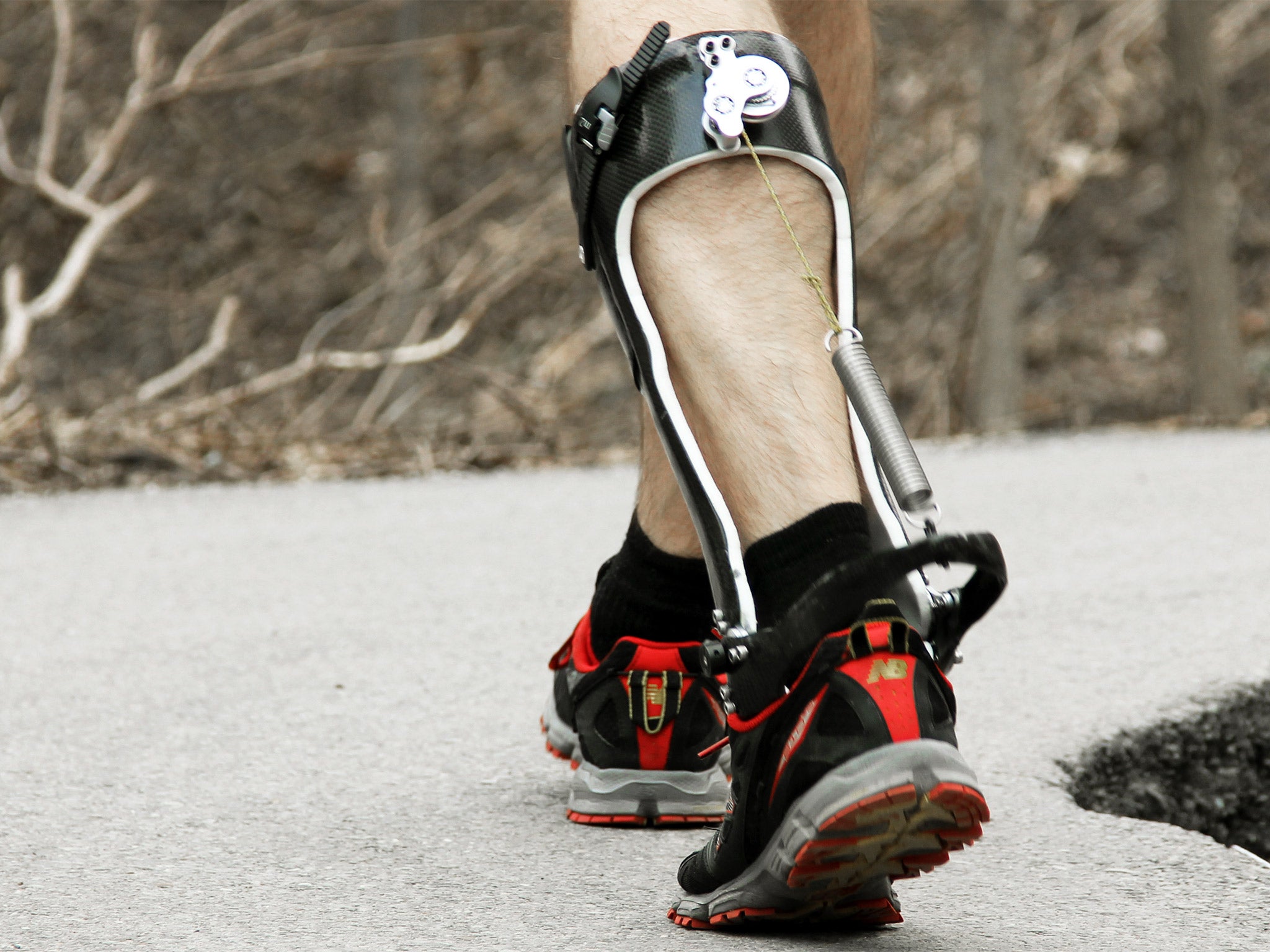Scientists develop mechanical spring-loaded leg brace to improve walking
The device boosts the performance of the calf muscles and the Achilles tendon by absorbing small amounts of energy when the foot hits the ground

Scientists have invented the first purely mechanical device to impart an extra spring in the footstep without the need for electric motors or batteries.
Tests have shown the spring-loaded brace worn on the lower half of the leg can improve walking efficiency by about 7 per cent, which is equivalent to removing a 4kg (9lb) load from someone’s backpack, the researchers said.
The inventors of the “exoskeleton” device said that it boosts the performance of the calf muscles and the Achilles tendon by absorbing small amounts of energy when the foot hits the ground, releasing it again when the foot is lifted through the air.
The inexpensive, lightweight device could have important uses for people who find it difficult to walk for long periods after illness, and might one day help long-distance walkers and runners, said Steven Collins, a mechanical engineer at the Carnegie Mellon University in Pittsburgh, Pennsylvania.
“Someday soon we may have simple, lightweight and relatively inexpensive exoskeletons to help us get around, especially if we’ve been slowed down by injury or ageing,” Dr Collins said.
Laboratory tests on nine people who had been trained to walk on a treadmill with a device strapped to each leg demonstrated that there was a significant saving in terms of the metabolic energy required for walking, according to a study published in the journal Nature.
“People expend more energy during walking than any other activity of daily life, and fatigue can limit mobility,” the researchers said.
“The device uses a mechanical clutch to hold a spring as it is stretched and relaxed by ankle movements when the foot is on the ground, helping to fulfil one function of the calf muscles and Achilles tendon,” they said.
Previous research led to the development of powered devices to improve walking efficiency but these are expensive and involve complicated motors and battery packs, Dr Collins said.
“This device is lightweight and simple with no batteries or motor. Instead of costing between $40,000 and $80,000 (£25,000-£50,000), it could cost just a few hundred dollars. People who find it difficult to walk because ageing or strokes could benefit,” he said.
It takes a couple of hours for someone to be trained in how to use the devices and it is relatively simple to adjust the tension of the spring to suit each individual, Dr Collins explained.
“When you first fit it on it feels a bit odd and strange but when you start to walk around with it on it soon feels comfortable and normal. But the real effect is when you take it off again – your foot feels heavy and weak afterwards,” he said.
It may be possible in the future to adapt the same principle to absorb the energy of walking in the upper half of the leg but developing a similar device for the knee and hips, Dr Collins added.
Gregory Sawicki, a biomechanical engineer at North Carolina State University and co-author of the study, said that the unpowered exoskeleton works “like a catapult” to reduce the load placed on the calf muscles and Achilles’ tendons.
“The clutch is essential to engage the spring only while the foot is on the ground, allowing it to store and then release elastic energy. Later it automatically disengages to allow free motion while the foot is in the air,” Dr Sawicki said.
“A 7 per cent reduction in energy cost is like taking off a 10-pound backpack, which is significant. Though it’s surprising that we were able to achieve this advantage over a system strongly shaped by evolution, this study shows that there’s still a lot to learn about human biomechanics and a seemingly simple behaviour like walking,” he said.
The researchers believe that healthy professionals who spend a lot of time on their legs, such as the military or airport staff, could also benefit from an unpowered exoskeleton that improves walking efficiencies.
Subscribe to Independent Premium to bookmark this article
Want to bookmark your favourite articles and stories to read or reference later? Start your Independent Premium subscription today.

Join our commenting forum
Join thought-provoking conversations, follow other Independent readers and see their replies